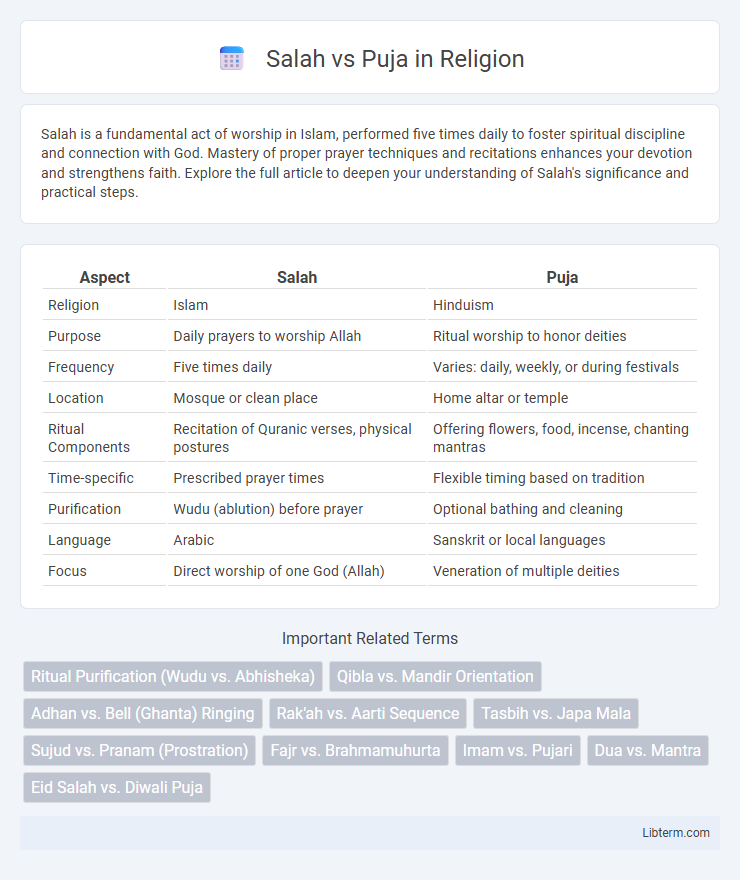Salah is a fundamental act of worship in Islam, performed five times daily to foster spiritual discipline and connection with God. Mastery of proper prayer techniques and recitations enhances your devotion and strengthens faith. Explore the full article to deepen your understanding of Salah's significance and practical steps.
Table of Comparison
| Aspect | Salah | Puja |
|---|---|---|
| Religion | Islam | Hinduism |
| Purpose | Daily prayers to worship Allah | Ritual worship to honor deities |
| Frequency | Five times daily | Varies: daily, weekly, or during festivals |
| Location | Mosque or clean place | Home altar or temple |
| Ritual Components | Recitation of Quranic verses, physical postures | Offering flowers, food, incense, chanting mantras |
| Time-specific | Prescribed prayer times | Flexible timing based on tradition |
| Purification | Wudu (ablution) before prayer | Optional bathing and cleaning |
| Language | Arabic | Sanskrit or local languages |
| Focus | Direct worship of one God (Allah) | Veneration of multiple deities |
Understanding Salah and Puja: Definitions and Origins
Salah is the Islamic ritual prayer performed five times daily, rooted in the Quran and Hadith, serving as a direct communication with Allah. Puja is a Hindu worship practice involving offerings to deities, originating from ancient Vedic traditions and texts like the Rigveda. Both rituals reflect deep spiritual significance and cultural heritage, representing distinct expressions of faith in Islam and Hinduism.
Core Beliefs Underpinning Salah and Puja
Salah, practiced by Muslims, is a ritual prayer performed five times daily, reflecting core beliefs in monotheism, submission to Allah, and spiritual discipline. Puja, a Hindu ritual, centers on devotion to selected deities, symbolizing faith in divine presence, cyclical time, and karma. Both rituals express core values of reverence and connection to the divine, though they differ in theological foundations and practices.
Ritual Structure: Steps in Salah vs. Puja
Salah consists of a fixed sequence of movements including standing (Qiyam), bowing (Ruku), prostrating (Sujood), and sitting (Jalsa), performed five times daily at prescribed times. Puja involves a flexible series of steps such as invoking deities through prayers (Mantras), offering items like flowers and food (Naivedya), and performing rituals with fire (Aarti), varying widely according to tradition and occasion. Each ritual's structure reflects its theological and cultural framework, emphasizing discipline in Salah versus ceremonial expression in Puja.
Timing and Frequency of Prayers
Salah, the Islamic prayer, is performed five times daily at specific times: Fajr (dawn), Dhuhr (midday), Asr (afternoon), Maghrib (sunset), and Isha (night), ensuring a structured spiritual routine. Puja in Hinduism varies in timing and frequency depending on family tradition and the deity worshipped, often conducted once or multiple times daily, with special prayers on festivals and auspicious days. The regularity of Salah is fixed by Islamic law, while Puja allows for more flexibility, accommodating personal devotion and cultural practices.
Physical Movements and Postures: A Comparative Analysis
Salah involves a series of precise physical movements and postures including standing, bowing (ruku), prostrating (sujood), and sitting (julus), performed in a specific sequence to express submission and reverence to Allah. Puja encompasses diverse gestures such as offering flowers, lighting lamps, and making circular hand movements (arati), combined with standing, sitting, or kneeling, varying by regional traditions and specific deities worshipped. Both practices use physicality to deepen spiritual connection, yet Salah emphasizes uniformity and ritualized body positions, while Puja reflects flexibility and symbolic actions attuned to cultural and theological contexts.
Spaces and Settings for Worship
Salah is performed in clean, often designated prayer spaces called musallas or mosques, where worshippers face the Kaaba in Mecca, emphasizing uniformity in direction and posture. Puja takes place in diverse settings, including home altars, temples, or outdoor shrines, with the arrangement of idols, flowers, lamps, and offerings tailored to specific deities and rituals. Both practices highlight the importance of sanctified environments, yet Salah mandates a strict orientation and cleanliness standard, while Puja embraces varied spatial and decorative elements reflecting cultural and devotional diversity.
Language and Scripts Used in Salah and Puja
Salah, the Islamic prayer, is traditionally performed in Classical Arabic, using the Arabic script for reciting verses from the Quran, ensuring linguistic consistency and preservation of original meanings. Puja, a Hindu ritual, varies linguistically across regions, often employing Sanskrit, Hindi, or local languages, with scripts like Devanagari or regional alphabets used for recitations and mantras. Both practices emphasize precise linguistic and scriptural usage to maintain the sanctity and authenticity of the prayers.
Symbolism and Sacred Items
Salah, an Islamic ritual, symbolizes submission to Allah and spiritual purification, with sacred items including the prayer mat and clean clothing to ensure ritual purity. Puja, a Hindu worship practice, represents devotion to deities and cosmic order, involving sacred items such as idols, incense, flowers, and lamps to invoke divine presence. Both rituals emphasize profound symbolism through their respective sacred objects, reinforcing spiritual connection and reverence in worship.
Communal vs. Individual Worship Aspects
Salah, the Islamic ritual prayer, emphasizes communal worship through congregation, with Muslims often praying together in mosques facing Mecca, fostering unity and collective spirituality. In contrast, Puja in Hinduism predominantly centers on individual worship, allowing devotees to perform personalized rituals at home or in temples, focusing on intimate connections with deities. This contrast highlights Salah's role in reinforcing communal identity, while Puja caters to personal devotion and diverse expressions of faith.
Spiritual Goals and Outcomes of Salah and Puja
Salah, the Islamic ritual prayer, aims to establish a direct connection with Allah, fostering spiritual discipline, mindfulness, and submission to divine will. Puja, a Hindu act of worship, seeks to invoke the presence of deities, cultivate devotion, and attain inner peace through ritualistic offerings and prayers. Both practices enhance spiritual growth, self-awareness, and the pursuit of ultimate liberation or closeness to the divine.
Salah Infographic

 libterm.com
libterm.com